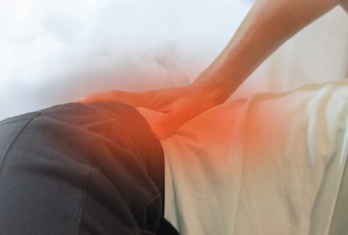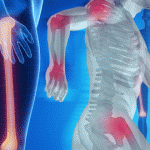‘One of the advantages of ultrasound is that you can characterize tendon, muscle & cortical bone abnormalities.’ —Ingrid Möller, MD, PhD
Sacroiliac Joint Pain
In a 2017 study of 100 patients with sacroiliac joint (SIJ) pain diagnosed by periarticular injection, researchers mapped the locations of patients’ pain, numbness and tingling.10 They found that 94 patients reported pain at or around the PSIS, and about 60% of patients reported lower limb pain and numbness or tingling sensations. Pain was detected mainly in the back, buttocks, groin and thighs, and numbness/tingling was mainly detected in the lateral and posterior thigh and posterior calf.
“How does the SI joint refer pain to the back?” asked Dr. Gillies. “It’s a misnomer. The low back goes from the 12th ribs to the gluteal folds, so you could divide it into two,” the lumbar region above the iliac crests and the buttock region below. “I’d suggest that when you talk about where the pain is, you say it’s in the lumbar region or it’s in the buttock region.”

BlurryMe / shutterstock.com
Structures in the buttock region do not refer pain to the lower back, because they are part of the lower back.11
“There are some anatomical concepts that really help you understand what happens in the sacroiliac joint. The synovial joints do three things: they roll, they slide and they spin. That’s it. But they can’t roll or slide on their own. These movements are coupled. They can spin on their own, but the rest of the movements are done together. That’s how joints move,” Dr. Gillies said. Codman’s paradox, a rotation of the shoulder joint, is an example of a coupled roll-and-slide movement. 12
“People always talk about sacroiliac joint subluxation,” such as chiropractic manipulation of the joint to treat irregular leg lengths, Dr. Gillies said. “If you dislocate a joint, the two joint surfaces are far apart. If you sublux them, that’s partial dislocation. I prefer to call this discentriclocation. When you extend your knee, there is a slide. It should end up resting in that central position. SI joints are not subluxed.” Patients with knee osteoarthritis often have uncoupled movements in this joint, she said.
Form closure and force closure work together in a stable, normal SI joint, and patients with malalignment of the SI joint often say they feel unstable, she said. Patients with SIJ pain may benefit from rolotherapy, injection of an irritant to cause localized inflammation that stimulates fibroblast hyperplasia and increased collagen production to promote healing.13
Another problem in low back pain are close-packed or loose-packed positioning of joints, said Dr. Gillies. While on a family vacation, her brother asked, “How do flamingos balance on one leg?” She explained that the joints of the bird’s standing leg are close packed. “Every joint has a close-packed position where it is like a pillar. In the flamingo, it’s in the ankle. So they can sleep standing on one leg with virtually no muscle energy whatsoever.”
How do birds achieve trunk stability to fly? “Flying birds have a fused cylinder, like an airplane. The only mobile bits are the neck and the distal part of the tail,” she said. “But how can we do that? We have to get that close-packed position in humans, where it is essentially fused, so when you bend forward, the sacrum moves. It’s called nutation.” A critical close-packed position in humans is full nutation in the L5 sacral joint, Dr. Gillies said.
To improve trunk stability for efficient load transfer, recommend that patients do alternating core exercises to strengthen abdominal and trunk muscles, although experts don’t fully agree on which exercises to include in a comprehensive program, Dr. Gillies concluded.14

